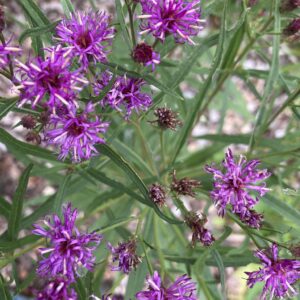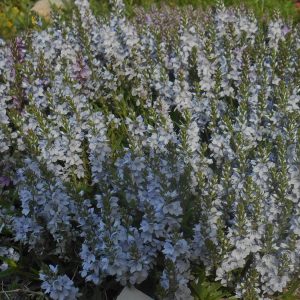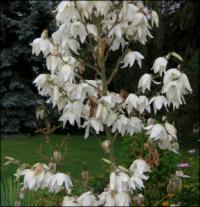Deer Resistant Plants
Showing 153–155 of 155 results
-
Vernonia lettermannii Threadleaf ironweed Z 4-9
Deep purple inch-wide flower heads top unbranched stems forming a dome in late summer-early fall
Deep purple inch-wide flower heads top unbranched stems forming a dome in late summer-early fall
Size: 24” x 36”
Care: sun in well-drained to moist well-drained soil
Native: Arkansas and OK
Wildlife Value: attracts numerous butterflies and pollen source for bees, deer resistant
Awards: Pennsylvania Horticultural Society Gold Medal 2023Collected on “Cooper’s Creek by Dr. J.M. Bigelow and on the sandbars of the Washita,.” Proc. Amer. Acad. Arts xvi. (1881) 78. 78 1880. “Notes on Some Compositae” The species named to honor George Lettermann (1840-1913) who was primarily interested in trees and, while working for the US Census he collected tree specimens in forests of Missouri, Arkansas, western Louisiana and eastern Texas.
-
Veronica prostrata syn. V. rupestris Sprawling speedwell, Harebell speedwelll Z 4-8
From midspring to midsummer short blue spikes above prostrate foliage.
OUT OF STOCK
From midspring to midsummer short blue spikes above prostrate foliage.
Size: 6” x 18”spreads
Care: sun to part shade in moist well-drained soil.
Native: Europe
Wildlife Value: Deer and rabbit resistant.
Awards: Royal Horticultural Society Award of Garden Merit.In gardens since at least 1753 (Linnaeus). Bloomed for 4 or more months in rock garden at Edinburgh Botanic Garden (The Garden, Jan. 1876.)
-
Yucca filamentosa Adam’s Needle, Silk grass Z 4-10
July – August flowers with translucent white bells but primarily grown for its spiky evergreen foliage.
OUT OF STOCK
July – August flowers with translucent white bells but primarily grown for its spiky evergreen foliage.
Size: 30" leaves - 5' flower x 3'
Care: full sun, moist well-drained to well-drained soil. Drought tolerant
Native: New Jersey to Florida
Wildlife Value: It’s only pollinator is the Yucca moth and the Yucca is the only food source for the Yucca moth in a mutually beneficial relationship.
Awards: England's Royal Horticultural Society Award of Garden Merit; Cary Award Distinctive Plants for New England and Elisabeth Carey Miller Botanical Garden Great Plant Pick.In 1596 Gerard named the genus Yucca from the incorrectly identified plant, the Iucca. Filimentosa is from the Latin “filum” meaning “thread” because of the threads on the leaf margins. Colonists cut the leaves of Y. filamentosa to make thread. Indians used the root as an ingredient in bread, to make suds for cleaning and the leaf fibers to make clothes. For the Cherokee it cured diabetes and skin sores, induced sleep in people and drugged fish for an easier catch. One of earlier No. American plants sent to Europe – grew in Tradescant the Younger’s South Lambeth nursery in 1656. Both Gerard and Parkinson grew Yucca filamentosa in their personal gardens. Jefferson planted Yucca filamentosa in 1794 and called it “beargrass.” Grown at Elgin Botanic Garden, America’s 1st botanic garden, 1811.



